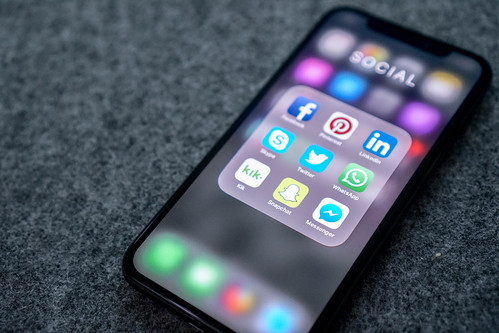
If you use Slack at work, maybe consider that everything in it can be saved.. and might prove embarrassing or even expensive. CC-licensed photo by Gustavo da Cunha Pimenta on Flickr.
You can sign up to receive each day’s Start Up post by email. You’ll need to click a confirmation link, so no spam.
A selection of 9 links for you. Don’t worry, nearly October. I’m @charlesarthur on Twitter. Observations and links welcome.
Google draws House antitrust scrutiny of internet protocol • WSJ
John D. McKinnon and Robert McMillan:
»
The Justice Department is aware of concerns over the protocol change and has recently received complaints, according to a person familiar with the matter.
The new standard would encrypt internet traffic to improve security, which could help prevent hackers from spoofing or snooping on websites.
But the new standard could alter the internet’s competitive landscape, cable and wireless companies say. They fear being shut out from much of user data if browser users move wholesale to this new standard, which many internet service providers don’t currently support. Service providers also worry that Google may compel its Chrome browser users to switch to Google services that support the protocol, something Google says it has no intention of doing.
“Right now, each internet service provider has insight into the traffic of their users, and that’s going to shift” as a result of the change, said Andy Ellis, chief security officer at Akamai Technologies Inc., which provides internet services to corporations, but doesn’t support the new standard.
Google, which has vast troves of consumer data thanks to its domination of search, plans to begin testing the navigation protocol with about 1% of its Chrome browser users next month, a first step toward more widespread adoption of the new technology.
Google says that it is supporting the new technology to improve users’ security and privacy and that its browser changes will leave consumers in charge of who shares their internet surfing data.
«
As the story explains, this is DNS-over-HTTPS, and the ISPs are furious about it because it will mean they can’t peek at peoples’ web traffic to insert “targeted” ads.
unique link to this extract
NPD forecasts growth in consumer tech through 2021 • NPD
Stephen Baker (who has been predicting consumer tech trends for ages):
»
Key trends to watch:
Big segments continue to dominate
• Core growth areas, including wireless headphones, smart home products, smart speakers, smartwatches, and gaming accessories and hardware (e.g., desktop and notebook PCs and monitors), are expected to triple in revenue from 2016 to 2021, while tech’s top three categories, notebooks (not including gaming), TVs, and tablets, will grow approximately 5 percent. That said, the revenue total for the top three sellers is $10B more than core growth areas — so the success of these big segments is especially critical to the industry.Niches can drive growth in the biggest and the smallest categories
• In a mature market, unit growth is unlikely, since there aren’t a lot of new customers to sell to. The biggest opportunity is to find underserved niches.New tech starts to impact growth in 2021
• New and emerging technologies we are starting to see in limited availability today will begin to have an impact by the end of 2021. Products like next-generation foldable screens, 5G, AR and others will have an impact in the not-so-distant future.Post-2021, the technology industry will undergo radical change
• What trends drive the inflection points?
1: The screen: whether foldable or transparent screens will be everywhere
2: The intelligent assistant: software that knows me and can help me with everyday tasks will drive tech purchases
3: Do-it-for-me devices: products that are intelligent and can do things for me will interest consumers
4: The connection: Inside the home, everything will be connected
5: Connectivity: connectivity to devices, to the cloud, and to the edge will be key.«
Transparent screens I could just about go for; foldable still feels like a stretch.
unique link to this extract
The anxiety-inducing peril of old Slack posts • NY Mag
Brian Feldman:
»
A lesser known fact about Slack is that its name is, according to the company’s founder Stewart Butterfield, an acronym. It stands for “Searchable Log of All Communication and Knowledge.” Not menacing at all.
The software lives up to its name. If you’re a certain type of masochist, you can drop into your new employer’s Slack and search your name (from NYMag’s Slack chat on August 19, 2014: “who’s brian feldman”). In 2016, my colleague Max Read had his innocuous Slack joke about Hulk Hogan read out in court during the lawsuit that eventually bankrupted Gawker Media. The communication logs were included in the discovery process, a good demonstration of why lawyers would always rather talk on the phone.
Writing for New York’s nascent tech vertical at the time, Read assessed, “There’s a bible’s worth of casual (or joking) shit-talking I’ve done in Gawker’s chat archives, some of which would make me very uncomfortable (if not unemployable) if it got out — a wealth of gossip and prattle I should have just conducted in person.” Unfortunately, the lessons of Hogan were soon forgotten.
Shortly after word got out that Bankoff had pledged to merge Vox’s and New York’s Slack channels, the staff of New York’s defunct tech vertical, Select All, agreed that we would request that chief product officer Daniel Hallac, our Slack admin, wipe the #select-all chatroom. (Slack has a function that auto-wipes messages on a regular interval, but in a workplace context, I think most have the understandable instinct to retain as much data as possible.) “I don’t think I can nuke it entirely but definitely make it hard to access,” he said. I’ll take it.
I will not say what was contained within, nor, honestly, can I even recall specific comments. But there were certainly ungenerous through lines in our insular chat bubble. There were comments aimed at competitors that were legitimate critiques. I’m not too proud to admit that others were remarks borne of petty jealousy. Most were probably a bit of both. Some comments were probably extremely funny, incredible, solid-gold quips. The thought of those targets combing through our Slack archives is so remote a possibility that it’s easy to put it out of mind. What fools we were.
«
Study proves the FCC’s core justification for killing net neutrality was false • VICE
Karl Bode:
»
For years, big ISPs and Trump FCC boss Ajit Pai have told anyone who’d listen that the FCC’s net neutrality rules, passed in 2015 and repealed last year in a flurry of controversy and alleged fraud, dramatically stifled broadband investment across the United States. Repeal the rules, Pai declared, and US broadband investment would explode.
“Under the heavy-handed regulations adopted by the prior Commission in 2015, network investment declined for two straight years, the first time that had happened outside of a recession in the broadband era,” Pai told Congress last year at an oversight hearing.
“We now have a regulatory framework in place that is encouraging the private sector to make the investments necessary to bring better, faster, and cheaper broadband to more Americans,” Pai proclaimed.
But a new study from George Washington University indicates that Pai’s claims were patently false. The study took a closer look at the earnings reports and SEC filings of 8,577 unique companies from Q1 2009 through Q3 2018 to conclude that the passage and repeal of the rules had no meaningful impact on broadband investment. Several hundred of these were telecom companies.
“The results of the paper are clear and should be both unsurprising and uncontroversial,” The researchers said. “The key finding is there were no impacts on telecommunication industry investment from the net neutrality policy changes. Neither the 2010 or 2015 US net neutrality rule changes had any causal impact on telecommunications investment.”
«
Shocked, shocked I tell you.
unique link to this extract
The internet is overrun with images of child sexual abuse. What went wrong? • The New York Times
Michael Keller and Gabriel Dance:
»
More than a decade ago, when the reported number was less than a million, the proliferation of the explicit imagery had already reached a crisis point. Tech companies, law enforcement agencies and legislators in Washington responded, committing to new measures meant to rein in the scourge. Landmark legislation passed in 2008.
Yet the explosion in detected content kept growing — exponentially.
An investigation by The New York Times found an insatiable criminal underworld that had exploited the flawed and insufficient efforts to contain it. As with hate speech and terrorist propaganda, many tech companies failed to adequately police sexual abuse imagery on their platforms, or failed to cooperate sufficiently with the authorities when they found it.
Law enforcement agencies devoted to the problem were left understaffed and underfunded, even as they were asked to handle far larger caseloads.
The Justice Department, given a major role by Congress, neglected even to write mandatory monitoring reports, nor did it appoint a senior executive-level official to lead a crackdown. And the group tasked with serving as a federal clearinghouse for the imagery — the go-between for the tech companies and the authorities — was ill equipped for the expanding demands.
A paper recently published in conjunction with that group, the National Center for Missing and Exploited Children, described a system at “a breaking point,” with reports of abusive images “exceeding the capabilities of independent clearinghouses and law enforcement to take action.” It suggested that future advancements in machine learning might be the only way to catch up with the criminals.
«
US tech companies copy the blame: “The companies have known for years that their platforms were being co-opted by predators, but many of them essentially looked the other way, according to interviews and emails detailing the companies’ activities.” Tumblr is also indicated as a big source of trouble.
(To the obvious question: is it more people, or just more images? “I think that people were always there, but the access is so easy,” said Lt. John Pizzuro, a task force commander in New Jersey. “You got nine million people in the state of New Jersey. Based upon statistics, we can probably arrest 400,000 people.”)
unique link to this extract
The failed political promise of Silicon Valley • The New Republic
Kim Phillips-Fein reviews Margaret O’Mara’s book “The Code: Silicon Valley and the Remaking of America”:
»
In 1952, the British historian Eric Hobsbawm wrote an essay titled “The Machine Breakers” for the journal Past and Present, in which he sought to present Luddism and the wrecking of industrial machinery as a reasonable tactic at a certain point in the development of the British labor movement, rather than an irrational and futile gesture. Workers, he argued, were hardly possessed by a passionate and unthinking fury that led them to destroy the mechanical looms and ricks. Instead, they did so in particular and targeted ways in order to augment their bargaining power at specific moments.
One is hard-pressed to find machine-breakers today; the writers chronicling their agonized efforts to quit the iPhone and the tech moguls panicking about the effects of screen time on their kids’ brains are the closest we’ve come so far. Still, The Code brings to mind Hobsbawm’s arguments about the politics of technology. For it suggests that the widespread discomfort with the technological regime is not only about the machines themselves. We live in a moment when the political consensus of the ’80s and ’90s is being called into question.
Faith in unregulated free markets has led to the dominion of the rich; the disinvestment in the public sector has led to the hollowing out of the institutions upon which democratic society rests. The tech industry seemed at one point to make material many dreams of the free market. It provided an image of a highly competitive economy that rewarded intelligence and daring, funded by venture capitalists with an ownership stake in the companies they built. As people challenge the social certitudes that rose in the ’80s, the slicker, brighter future that machines promised looks shakier too. This deepening unease about technology—and the spaces that have nurtured it, like Silicon Valley—is testament to the shifting politics of our time.
«
The new productivity • Benedict Evans
Evans on how everything’s becoming workflowed now:
»
a few years ago a consultant told me that for half of their jobs they told people using Excel to use a database, and for the other half they told people using a database to use Excel. There’s clearly a point in the life of any company where you should move from the list you made in a spreadsheet to the richer tools you can make in coolproductivityapp.io. But when that tool is managing a thousand people, you might want to move it into a dedicated service. After all, even Craigslist started as an actual email list and ended up moving to a database. But then, at a certain point, if that task is specific to your company and central to what you do, you might well end up unbundling Salesforce or SAP or whatever that vertical is and go back to the beginning.
Of course, this is the cycle of life of enterprise software. IBM mainframes bundled the adding machines [from offices of the 1950s], and also bundled up filing cabinets and telephones. SAP unbundled IBM. But I’d suggest there are two specific sets of things that are happening now.
First, every application category is getting rebuilt as a web application, allowing continuous development, deployment, version tracking and collaboration. As Frame.io (video!) and OnShape (3D CAD!) show, there’s almost no native PC application that can’t be rebuilt as a web app. In parallel, everything now has to be native to collaboration, and so the model of a binary file saved to a file share will generally go away over time (this could be done with a native PC app, but in practice generally won’t be). So, we have some generational changes, and that also tends to create new companies.
But second, and much more important – everyone is online now. The reason we’re looking at nursing or truck drivers or oil workers is that an entire generation now grew up after the web, and grew up with smartphones, and assumes without question that every part of their life can be done with a smartphone. In 1999 hiring ‘roughnecks’ in a mobile app would have sounded absurd – now it sounds absurd if you’re not.
«
Will the Ukraine scandal be Trump’s downfall? • NY Mag
Jonathan Chait:
»
Giuliani’s original goal was to prod Ukraine to turn over evidence that would exonerate Paul Manafort, the former Trump campaign manager. Manafort had worked in Ukraine for a pro-Russian party, then gone on to manage Trump’s campaign while maintaining secret contacts with a Russian intelligence officer, and he was helping Trump in 2018 by withholding cooperation from special counsel Robert Mueller. Giuliani was attempting to prove that Manafort had been set up by Ukrainians working with the Clinton campaign and that — even more bizarrely — Ukrainians had stolen Clinton’s emails.
If these theories sound fantastical, they are. But just as Watergate demystified the White House staff as bumblers, the Ukraine scandal has revealed Trump and his allies are suffering from Fox News poisoning. The bizarre conspiracy theories that the rest of us took to be devious propaganda had a profound impact on the president and his inner circle. They are not-very-bright guys who also happen to be genuinely nuts.
But the mission followed a coherent strategic goal. Trump thrives on cynicism, excusing his misconduct with the assumption everybody does it — simultaneously condoning his own failings while dragging his antagonists down to his level. His election required many Americans to believe his opponent had engaged in criminal behavior. He has instinctively replicated those conditions in his quasi-campaign against Mueller as well as against the Democrats in 2020.
In the course of his work, Giuliani made contact with Ukrainian prosecutors and hit upon yet another conspiracy theory. The story held that, during the Obama administration, Joe Biden had called for the firing of a prosecutor who was on the tail of a Ukrainian firm that had hired his son Hunter. This theory, too, was wrong. Hunter Biden had gone to work for a Ukrainian energy firm as part of a generally sleazy practice of trading on his father’s name. And it was true that Joe Biden spearheaded demands to fire a prosecutor. But the prosecutor was not investigating Hunter Biden’s firm at that time. And the vice-president’s call to fire the prosecutor, who was notoriously ineffectual at rooting out corruption, placed him squarely on the side of human-rights activists, democratic countries, the IMF, the World Bank, and other international do-gooders.
«
It’s amazing what nonsense Guiliani, and Trump, are willing to believe. It’s as if their grasp on reality long ago became unmoored. But as the writeup also makes clear, the vice-president Mike Pence almost surely knew about the illegal actions too. Can they both be impeached?
unique link to this extract
iOS 13 hidden features: mute Mail threads, silence unknown callers, reading goals, low data mode and more • MacRumors
Juli Clover:
»
Apple this week debuted iOS 13 with a ton of updates, including a new dark mode option, major performance improvements, faster Face ID, simpler photo editing tools and a new Photos interface, a Sign In With Apple Privacy feature, a swipe-based keyboard, and tons more.
In addition to these features that made it into Apple’s keynote event, there are dozens if not hundreds of smaller new changes and tweaks that are included in iOS 13. Below, we’ve rounded up a comprehensive list of new and notable “hidden” features in iOS 13.
«
These are quite fun (obviously only really useful if you run iOS..), though some seem to be device-specific: using an iPhone X, I don’t get the “Facetime Attention Correction” which would make you seem to be looking at the caller even though you aren’t.
unique link to this extract
Errata, corrigenda and ai no corrida: none notified





:gifv():no_upscale()/cdn.vox-cdn.com/uploads/chorus_image/image/65307913/mix.0.0.gif)






